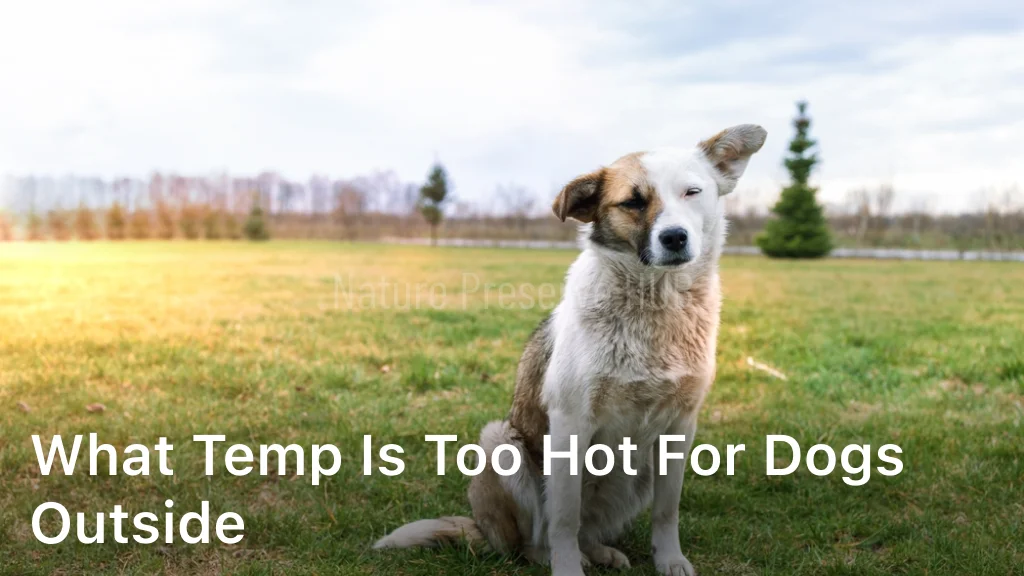What Temp is Too Hot for Dogs Outside?

naturepreservehub.com. What Temp is Too Hot for Dogs Outside? – Learn with us about “what temp is too hot for dogs” when they’re outside. Protect your pets from overheating and ensure their safety and comfort today!
As dog owners, we want our pets to enjoy the great outdoors. However, it’s essential to understand that dogs are more susceptible to heat-related illnesses compared to humans.
In this section, we will explore the temperature thresholds that could be harmful to dogs when they are outside. Understanding these limits is critical for ensuring the well-being and safety of your furry companions.
What Temp is Too Hot for Dogs Outside?
Key Takeaways:
- Dogs are more sensitive to heat than humans
- Understanding the ideal temperature range for dogs is crucial
- Dogs cannot communicate their discomfort verbally
- Signs of overheating should be recognized immediately
- Preventive measures can protect dogs from heat-related illnesses

Understanding a Dog’s Heat Sensitivity
As dog owners, we must understand that our furry companions are more sensitive to heat than humans and can suffer from heat stress and heat stroke, especially during hot summer months.
Dogs have a limited ability to regulate their body temperature and rely mainly on panting to cool down. This makes them particularly vulnerable to heat-related illnesses and dehydration.
We can compare a dog’s heat sensitivity to cooking a steak: When cooking a steak, we have a temperature range that we need to stay within to ensure that it’s cooked correctly. Too high of heat can dry it out or burn it, while too low of heat will leave it undercooked. Similarly, dogs have a temperature range that they thrive in.
The Science Behind Dogs’ Heat Sensitivity
Dogs primarily release heat through their respiratory tract by panting and through their paw pads by sweating. Unlike humans, dogs do not have sweat glands all over their bodies. This is why it’s essential to keep their paw pads hydrated to help regulate their body temperature. However, when the surrounding temperature is too high or humidity is too low, evaporative cooling can become ineffective.
When a dog’s body temperature exceeds a certain threshold, usually around 103°F, their body’s natural cooling mechanisms become less effective, and heat stress can occur. If their temperature surpasses 106°F, they can develop heat stroke, a life-threatening condition that requires immediate veterinary attention.
Identifying Signs of Heat-Related Distress in Dogs
It’s essential to recognize the signs of overheating and distress in your dog. Early intervention can prevent more severe conditions from developing. Here are some signs of heat-related stress to watch out for:
- Heavy panting and rapid breathing
- Excessive drooling and salivating
- Gums and tongue turning bright red
- Sleepiness or lack of energy
- Vomiting and diarrhea
- Difficulty standing or walking and Collapsing
If your dog exhibits any of these symptoms, move them to a cool, shaded area immediately. Offering small amounts of cool water and using a fan can help to lower their body temperature. However, if they are showing signs of heat stroke, it is crucial to seek veterinary attention right away.
Ideal Temperature Range for Dogs
As pet owners, it’s crucial to understand the ideal temperature range for dogs to ensure their comfort and well-being. Dogs are highly sensitive to heat, and when they are exposed to extreme temperatures, it can result in heat-related illnesses that can be life-threatening. The ideal temperature range for dogs can depend on several factors such as breed, age, and overall health.
Generally, dogs feel most comfortable in temperatures ranging from 60°F to 75°F. Anything above 75°F can be uncomfortable for some dogs and potentially harmful for others. Breeds with short snouts such as bulldogs and pugs, as well as dogs with thick fur coats, may have a lower threshold for heat and can feel uncomfortable in temperatures as low as 70°F.
It’s crucial to monitor your dog’s behavior and watch for signs of distress when they are exposed to warmer temperatures. If the weather is hot and humid, it’s recommended to keep your dog indoors in a cool, air-conditioned environment.
Factors Affecting a Dog’s Tolerance to Heat
Several factors can affect a dog’s tolerance to heat beyond breed and coat type. These include:
- Age: Puppies, senior dogs, and dogs with health conditions may have a lower tolerance for heat due to their age or underlying health issues.
- Weight: Overweight dogs may have a more challenging time regulating their body temperature and may overheat more easily than their lean counterparts.
- Activity Level: Dogs that are very active or have a high energy level may overheat more quickly than those that are less active.
Keeping Your Dog Comfortable in Warm Weather
There are several ways to keep your dog comfortable and safe during warm weather, including:
- Providing plenty of fresh, cool water to prevent dehydration
- Creating a shaded area outside for your dog to relax in
- Avoiding outdoor activities during the hottest parts of the day
- Never leaving your dog alone in a parked car, even if it’s just for a few minutes
By understanding the ideal temperature range for dogs and taking the necessary precautions, we can ensure our furry companions stay happy and healthy no matter the weather.
Warning Signs of Overheating in Dogs
As we mentioned in the previous section, dogs are more vulnerable to overheating than humans. They cannot sweat like we do and rely on panting to regulate their body temperature. When they are exposed to high temperatures and humidity, their cooling system can fail, leading to heat exhaustion or heatstroke, which can be life-threatening.
It’s crucial to recognize the warning signs of overheating in dogs so that you can take immediate action to cool them down and prevent further complications. Here are some common symptoms to look out for:
- Excessive panting: When dogs are overheating, they will pant more rapidly and excessively than usual. This is their primary cooling mechanism, but if it doesn’t work, it can lead to respiratory distress.
- Dehydration: Overheated dogs may experience dry, tacky gums, and sunken eyes. Their skin may also lose elasticity, meaning that it takes longer for the skin to fall back into place when gently pulled.
- Disorientation: Dogs may appear confused, dizzy, or disoriented when they are overheating. They may stumble or have difficulty walking, and their eyes may appear glassy or unfocused.
- Vomiting or diarrhea: Overheating can cause gastrointestinal distress, leading to vomiting or diarrhea. This can exacerbate dehydration and cause further complications.
- Collapse: In severe cases, dogs may collapse or experience seizures. If this happens, it’s essential to seek medical attention immediately.
If you notice any of these symptoms in your dog, it’s crucial to take immediate action to cool them down and prevent further complications. Move your dog to a shaded and cool area, provide them with plenty of water (not ice-cold), and wet them with cool water, especially on their paw pads and belly. Avoid using ice-cold water or an ice bath, as this can cause blood vessels to constrict, making it harder for the body to dissipate heat.
If your dog’s condition does not improve or worsens, seek veterinary assistance immediately. Remember that prevention is always the best approach, so it’s crucial to monitor your dog’s behavior and avoid exposing them to high temperatures and humidity. By being informed and taking proactive measures, you can help protect your furry friend from the dangers of overheating.
Preventing Heat-Related Illnesses in Dogs
As responsible pet owners, it’s our duty to keep our furry friends safe in hot weather. Here are some practical tips and guidelines on preventing heat-related illnesses in dogs:
- Provide plenty of fresh, clean water: Make sure your dog always has access to clean water, especially during the hot summer months. Dehydration is a significant risk factor for heatstroke, so make sure your dog stays well-hydrated at all times.
- Avoid excessive exercise: It’s best to limit your dog’s outdoor activity during the hottest parts of the day. Early morning and late evening walks are ideal, as temperatures are cooler during these times. If you do go out in the heat, keep the activity level low and take frequent breaks in shaded areas.
- Create a shaded environment: Make sure your dog has access to a shaded area at all times, whether it’s a covered porch, canopy, or tree. Avoid leaving your dog in a parked car, as temperatures can rise quickly and cause heatstroke.
- Provide proper ventilation: Good air circulation helps reduce heat buildup, so make sure your dog’s area is well-ventilated. If your dog is indoors, turn on the air conditioning or a fan to keep the room cool.
- Monitor your dog’s behavior: Watch for signs of heat stress, such as excessive panting, drooling, lethargy, or vomiting. If you notice any of these symptoms, immediately move your dog to a shaded area, offer water, and seek veterinary care.
Remember, prevention is key to keeping your dog safe from heat-related illnesses. By following these simple guidelines, you can ensure your furry friend stays healthy and comfortable all year round.
Conclusion
Now that we have delved into the topic of what temperature is too hot for dogs outside, it is crucial to keep in mind that every dog is unique and may have different sensitivity levels to heat. It is essential to pay close attention to your furry friend’s behavior and body language to identify any signs of heat stress.
Remember, dogs rely on their owners to keep them safe and healthy, and it is our responsibility to take preventive measures to protect them from extreme temperatures. By providing a shaded and cool environment, ensuring proper hydration, and avoiding excessive exercise during hot weather, we can significantly reduce the risk of heat-related illnesses in our pets.
Let’s prioritize the well-being of our furry companions and take action to keep them safe and comfortable, even during the hottest months of the year. Together, we can ensure that our pets live their best lives and enjoy the outdoors without any harm or discomfort.
FAQ
What temperature is too hot for dogs outside?
Dogs can be susceptible to heat-related illnesses when the temperature exceeds their comfort range. As a general guideline, if the temperature is over 90 degrees Fahrenheit (32 degrees Celsius), it is considered too hot for dogs to be outside for an extended period. However, factors such as humidity and breed can also affect a dog’s tolerance to heat.
Why are dogs more sensitive to heat?
Dogs have a limited ability to regulate their body temperature compared to humans. They primarily rely on panting and sweating through their paws to cool down. This makes them more prone to overheating, especially in hot and humid conditions. Additionally, certain breeds with shorter snouts are at a higher risk of heat-related distress.
What is the ideal temperature range for dogs?
Dogs are most comfortable in a temperature range between 65-75 degrees Fahrenheit (18-24 degrees Celsius). However, it’s important to consider other factors such as breed, age, and overall health. Some dogs may have a higher or lower tolerance to heat, so it’s crucial to monitor their behavior and adjust their exposure accordingly.
What are the warning signs of overheating in dogs?
Signs of overheating in dogs include excessive panting, drooling, rapid breathing, weakness, disorientation, vomiting, and collapse. If you notice any of these symptoms, it’s important to take immediate action to cool your dog down and seek veterinary assistance if necessary.
How can I prevent heat-related illnesses in dogs?
To prevent heat-related illnesses in dogs, ensure they have access to fresh water at all times and provide shade in outdoor areas. Avoid exercising them during the hottest parts of the day and never leave them unattended in a parked car, even for a short period. If you need to take your dog outside on a hot day, consider using protective booties, cooling vests, or taking breaks in shaded areas.
What precautions should I take during hot weather?
During hot weather, it’s important to keep your dog cool and comfortable. Limit their exposure to direct sunlight, provide plenty of fresh water, and avoid strenuous activities during peak heat hours. If possible, walk your dog early in the morning or late in the evening when temperatures are cooler. Monitor their behavior closely and seek veterinary attention if you suspect they are experiencing heat-related distress.
How do I know if my dog is at risk for heat-related illnesses?
All dogs are at risk of heat-related illnesses, but certain breeds, such as brachycephalic breeds (e.g., Bulldogs, Pugs), older dogs, overweight dogs, and dogs with pre-existing health conditions are more vulnerable. It’s important to be extra cautious with these dogs and take proactive measures to prevent overheating.
Can I give my dog ice cubes or frozen treats to cool them down?
While giving your dog ice cubes or frozen treats can provide temporary relief from the heat, be cautious not to give them too much too quickly. Rapidly ingesting large amounts of ice or frozen treats can lead to stomach upset or even a condition called bloat. It’s best to let the ice cubes melt a bit or offer smaller portions to avoid any potential issues.
What should I do if I suspect my dog is overheating?
If you suspect your dog is overheating, immediately move them to a cool, shaded area and offer them water. You can also dampen their fur with cool (not cold) water or use a fan to facilitate evaporation. Contact your veterinarian for further guidance, as they may recommend bringing your dog in for a check-up.
How long can dogs safely be outside in hot weather?
The length of time dogs can safely be outside in hot weather depends on various factors, including the temperature, humidity, breed, and individual tolerance. As a general rule, it is best to limit their time outdoors during the hottest parts of the day and provide them with a cool, shaded area when they are outside.





